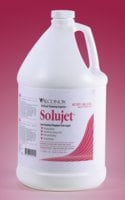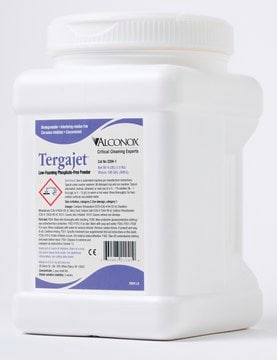Z742930
Keylajet® detergent, low foaming high alkaline liquid
pkg of 19 L
Sinónimos:
free rinsing cleaner, high alkaline liquid, tough-to-clean residue remover
Iniciar sesiónpara Ver la Fijación de precios por contrato y de la organización
About This Item
UNSPSC Code:
47131800
NACRES:
NB.34
Productos recomendados
packaging
pkg of 19 L
manufacturer/tradename
Alconox, Inc.
application(s)
sample preservation
General description
Keylajet low-foaming chelating alkaline detergent
Used to clean: Manufacturing equipment, cosmetics residues, injection molds, fouled metal parts in maintenance and repair operations from marinas to automotive to aerospace to oil & gas, such as filters, fins, exchangers, pump heads, steel engine blocks, exhaust systems, and more; metal castings, forgings and stampings, industrial parts, pipes, tanks and reactors. Use to clean steel prior to passivation.
Used to remove: Hard to clean soils, grit, grime, slime, grease, buffing compounds, oils, particulates, deposits, chemical and solvents, mold releases, metal oxides, and much more.
Surfaces cleaned: Corrosion inhibited formulation recommended for hard metals, steels, stainless steel, porcelain, ceramic, rigid plastics, cement, and elastomers. Do not use on soft metals such as copper, aluminum, zinc and magnesium.
Cleaning method: Soak, spray, brush, sponge, cloth, ultrasonic, flow through clean-in-place, agitation, or automated washing. Please ensure gasket compatibility.
Directions: Make a fresh 1% solution (2 1/2 Tbsp. per gal., 1 1/4 oz. per gal. or 10 ml per liter) in warm or hot water. For difficult soils or to remove metal oxides, raise water temperature and use more detergent, up to 10% by volume. Clean by soak, circulate, wipe, spray, or ultrasonic method. RINSE THOROUGHLY—preferably with running water.
For critical cleaning, do final or all rinsing in distilled, deionized or purified water. For food contact surfaces, rinse with potable water. Corrosion testing may be advisable for high-carbon steels, and may require rust preventative application post-cleaning.
- Concentrated to save you money
- Corrosion inhibited formula
- Caustic liquid detergent with chelators
- Free rinsing to give you reliable results and no interfering residues
- For tough-to-clean residues on hard surfaces
Used to clean: Manufacturing equipment, cosmetics residues, injection molds, fouled metal parts in maintenance and repair operations from marinas to automotive to aerospace to oil & gas, such as filters, fins, exchangers, pump heads, steel engine blocks, exhaust systems, and more; metal castings, forgings and stampings, industrial parts, pipes, tanks and reactors. Use to clean steel prior to passivation.
Used to remove: Hard to clean soils, grit, grime, slime, grease, buffing compounds, oils, particulates, deposits, chemical and solvents, mold releases, metal oxides, and much more.
Surfaces cleaned: Corrosion inhibited formulation recommended for hard metals, steels, stainless steel, porcelain, ceramic, rigid plastics, cement, and elastomers. Do not use on soft metals such as copper, aluminum, zinc and magnesium.
Cleaning method: Soak, spray, brush, sponge, cloth, ultrasonic, flow through clean-in-place, agitation, or automated washing. Please ensure gasket compatibility.
Directions: Make a fresh 1% solution (2 1/2 Tbsp. per gal., 1 1/4 oz. per gal. or 10 ml per liter) in warm or hot water. For difficult soils or to remove metal oxides, raise water temperature and use more detergent, up to 10% by volume. Clean by soak, circulate, wipe, spray, or ultrasonic method. RINSE THOROUGHLY—preferably with running water.
For critical cleaning, do final or all rinsing in distilled, deionized or purified water. For food contact surfaces, rinse with potable water. Corrosion testing may be advisable for high-carbon steels, and may require rust preventative application post-cleaning.
Legal Information
Keylajet is a registered trademark of Alconox, Inc.
signalword
Danger
hcodes
Hazard Classifications
Acute Tox. 4 Oral - Eye Dam. 1 - Met. Corr. 1 - Skin Corr. 1A
Storage Class
8A - Combustible corrosive hazardous materials
wgk_germany
WGK 3
Certificados de análisis (COA)
Busque Certificados de análisis (COA) introduciendo el número de lote del producto. Los números de lote se encuentran en la etiqueta del producto después de las palabras «Lot» o «Batch»
¿Ya tiene este producto?
Encuentre la documentación para los productos que ha comprado recientemente en la Biblioteca de documentos.
Nuestro equipo de científicos tiene experiencia en todas las áreas de investigación: Ciencias de la vida, Ciencia de los materiales, Síntesis química, Cromatografía, Analítica y muchas otras.
Póngase en contacto con el Servicio técnico









